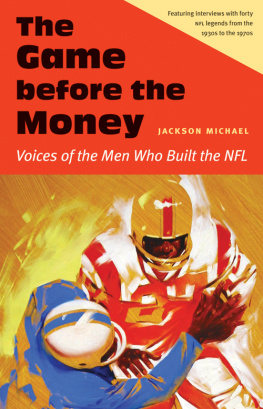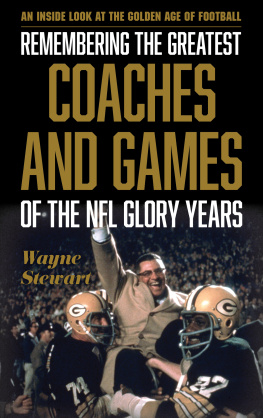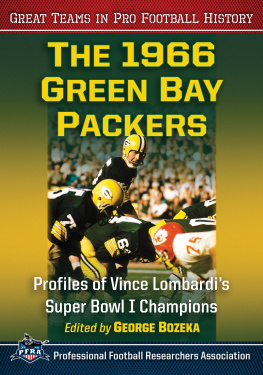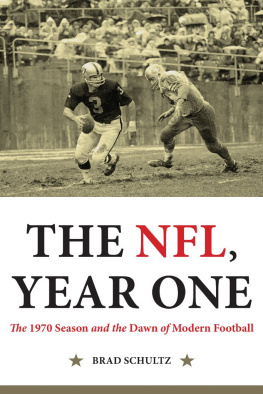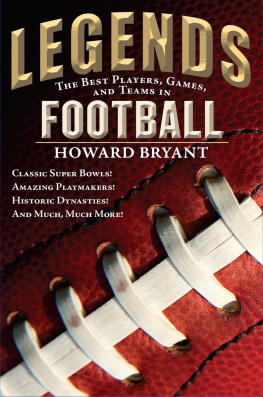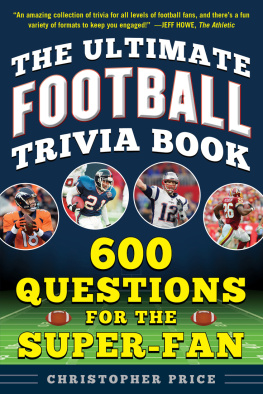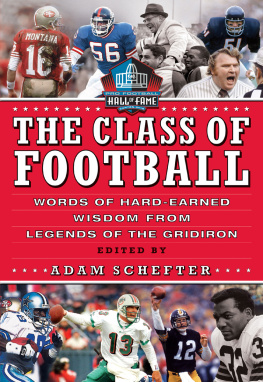
Original and far more interesting than fiction, these stories need no garnishment. Jackson Michael humbly asks, listens, and writes. His stated goal of delivering NFL history directly from the mouths of the men who made it is achieved with all the flair of a simple dive play that busts open for a forty-yard touchdown.
Doug English, NFL All-Pro Defensive Tackle
The Game before the Money
The Game before the Money
Voices of the Men Who Built the NFL
Jackson Michael
University of Nebraska Press
Lincoln & London
2014 by Jackson Michael
All photographs in the text are courtesy of the author unless otherwise noted.
Cover image by Lon Keller is courtesy of Jay Keller.
Author photo courtesy of Julie/Wiseshots Photography.
A portion of the sales of this book will be donated to the following football-related charities:
Lone Star Paralysis Foundation, Doug English, President. The mission of the Lone Star Paralysis Foundation is to cure paralysis from spinal cord injury by funding research, recovery therapy, and community outreach. We call it our three R s: Research, Recovery, and Recreation. We are working to move the clock forward on a cure.
http://www.LoneStarParalysis.org/
Retired Players Association, Carl Eller, President.
http://www.NFLRetiredPlayersAssociation.org/
Pro Football Hall of Fame Enshrinees Assistance Foundation.
All rights reserved
Library of Congress Control Number: 2014943025
The publisher does not have any control over and does not assume any responsibility for author or third-party websites or their content.
When you leave, you got your friends and your memories. Thats it. Hopefully, you cultivated both of them.
Walt Garrison, Dallas Cowboys
Contents
Before free agency, professional football was generally an unstable, unpredictable job, paying roughly a middle-class wage. It was seasonal work providing minimal retirement benefits and guaranteed to be temporary.
The game also offered an excitement and competitive challenge few occupations could match, not to mention hordes of cheering spectators, television coverage, and the accompanying notoriety. On the other hand, a career could end at any moment, outside of ones control.
Football first topped Gallups poll as Americas favorite sport in 1972, but baseball has long held the market on nostalgia. A delight in the personalities that played the grand old gamefrom Stan Musials charm to Ty Cobbs sournesscultivates baseballs endearing timelessness.
Football history, however, is rarely presented in such fashion. Many writers simply depict football players in gladiator-like stereotypes that are frequently inaccurate. Often the athletes off-field demeanor stands in contrast to the gridirons stoic image.
The Game before the Money is simply a book by a fan who dreamed of having a book like this upon his own bookshelf. I was frustrated by the dearth of pro football history presented in an authentic, genuine fashion, beyond the typical sportswriter angles of iron, blood, and guts. I wished to know these men beyond stereotypes, learn about their lives, and celebrate their contributions to both the game and our countrys culture.
When sports artist Robert Hurst heard my idea to do an oral history of pro football, he invited me to attend Bob Lillys annual golf tournament at the Texas Sports Hall of Fame. That kick-started the project and led to interviews with Ken Houston, Elvin Bethea, and Walt Garrison.
I put my professional music career on hold and brainstormed a four-page dream list of players I hoped to interview. My good friend Karl Anderson tossed in a few vintage football cards of the players for good luck. Remarkably, I wound up contacting a large percentage of the names on the list. Meanwhile, I started working full time in a mailroom to pay the bills.
Assembling this book was a tremendous privilege. My objective was to document both football history and the individuals who played the game while conveying what its like to be a pro football player. To get a range of perspectives, attempts were made to include stars as well as journeymen and players who only played a few seasons.
These pages contain the life stories of NFL legends, a history of football from their perspective, backstories to classic game moments, and glimpses into NFL life by those most capable of offering themthe men who created that history, lived those backstories, and experienced the NFL firsthand.
These men have won the Super Bowl and the Heisman Trophy. Theyve collected All-Pro and All-American honors and had their numbers retired by major universities and pro football teams. Several have earned spots in the Pro Football Hall of Fame; the majority are in the College Football Hall of Fame. Many have been featured on the covers of Time and Sports Illustrated. All have tremendous stories to tell.
I expected to learn a lot about football while compiling this anthology. I also unexpectedly learned a great deal about life. Virtually every one of the players discussed here tied some sort of valuable life lesson to his story, either in a purposeful or an indirect way.
A grand set of elders spinning yarns speckled with wisdom is a wonderful gift. As you prepare to enter the locker rooms of Vince Lombardi and Tom Landry and step onto the field with Bronko Nagurski, Walter Payton, and Terry Bradshaw, know that in the hearts and minds of many of these men, success in football, business, and life are all connected.
The Game before the Money
Players Whose Careers Began before 1950
Before the 1950s, the single-wing formation dominated football, pro players were usually paid per game rather than annual salary, and All-Americans like Al Wistert worked their way through college. African Americans were barred from the NFL between 1933 and 1946, an unwritten policy generally attributed to Redskins owner George Preston Marshall, although racial restrictions were standard at every level of competition throughout athletics. Many college stars eschewed pro football. Virtually every pro player worked a job outside of football, a trend that continued into the 1980s. Like starving artists, many risked professional and financial futures to pursue football.
World War II impacted young mens dreams of pro and collegiate careers. Pro players left their NFL coaches for drill sergeants; college athletes enrolled in the armed services rather than spring semester classes. Draft notices trumped scholarship offers in the mailboxes of high school graduates, replacing gridiron action with combat on the battlefields of Europe and the Pacific.
Pro Football before the 1950s Timeline
1920: American Professional Football Association forms in Canton, Ohio.
1921: Fritz Pollard becomes first African American head coach.
1922: American Professional Football Association changes name to National Football League.
1925: Red Grange signs with the Chicago Bears. Grange receives percentage of gate receipts, later claims having received $50,000 for one game and $35,000 for another.
1933: No African Americans appear on NFL rosters for the first time in league history.
1935: Bidding war pushes Stan Kostkas rookie contract to $5,000similar to established star Bronko Nagurskis. Philadelphia owner Bert Bell suggests a player draft, limiting players to one pro football employment option.
1936: NFL conducts its first player draft, Jay Berwanger being the top selection. He chooses a higher-paying career in the foam-rubber industry. Second-overall pick Riley Smith signs for $250 per game.
1939: World War II begins; 638 pros end up joining war effort, 21 killed in action. NFL regular season attendance tops 1 million for first time.
Next page
